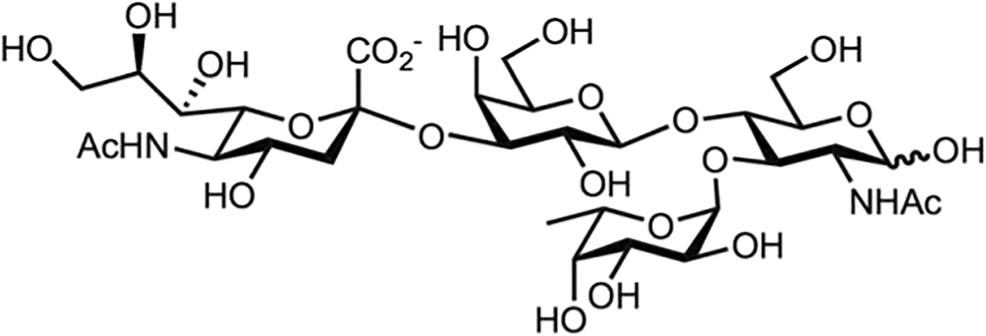In previous posts, we discussed the chemistry of sugars as important parts of the structure of antibiotics, and the importance of sugars in toxic molecules in foods. Today, we will discuss one other function of sugars in the human body: cell recognition.
Many of you are probably familiar with the ABO system of blood types. This is based on the presence of A and B antigens on the surface of red blood cells, which is especially important for blood transfusions to avoid unwanted immune reactions. The A blood type is characterized by the presence of the A antigen, the B blood type has B antigen present, AB has both, and O has neither. But what are these antigens?

Polysaccharides present on red blood cells in the ABO system. Source: https://www.researchgate.net/figure/Biochemical-basis-of-ABO-groups_fig1_233799814
This system actually refers to different polysaccharides present on the surface of red blood cells, attached to lipids and proteins. The base of the A and B antigens is the H antigen, present in people with type O blood [1]. The H antigen is then subsequently modified by enzymes by the addition of other sugars to form the A or B antigens. The sugars involved include fucose, galactose, N-acetylglucosamine, and N-acetylgalactosamine. These last two compounds are derived from glucose and galactose from the addition of an amine and an acetyl group [2] [3].
Another important carbohydrate is Sialyl-Lewis X (sLeX) which is important for white blood cells to travel to the affected site when an inflammatory response occurs. Cells in the inner layer of blood vessels in express proteins called selectins, which bind to sLeX on white blood cells and cause the cells to slow down, allowing them to move through out of the blood vessel and into the site of inflammation [4].

Structure of Sialyl-Lewis X. Source: https://link.springer.com/article/10.1007/s10719-020-09912-4/figures/1
As you can see, sugars have many other roles in the body other than just being energy sources! There are also other roles we haven’t discussed. Stay tuned and we may cover them in future posts!
Sources:
1. Dean L. The Hh Blood Group. National Center for Biotechnology Information (US); 2005. Accessed July 20, 2021. https://www.ncbi.nlm.nih.gov/books/NBK2268/
2. Dean L. ABO Blood Group. In: Pratt VM, Scott SA, Pirmohamed M, et al., eds. Medical Genetics Summaries. National Center for Biotechnology Information (US); 2012. Accessed July 20, 2021. http://www.ncbi.nlm.nih.gov/books/NBK100894/
3. Wood E, Shortt J, Polizzotto M. Controversies and innovations in the management of critical bleeding and massive transfusion in trauma. Defence Medical Debate. 2008;1:15-23.
4. Jin F, Wang F. The physiological and pathological roles and applications of sialyl Lewis x, a common carbohydrate ligand of the three selectins. Glycoconj J. 2020;37(2):277-291. doi:10.1007/s10719-020-09912-4
